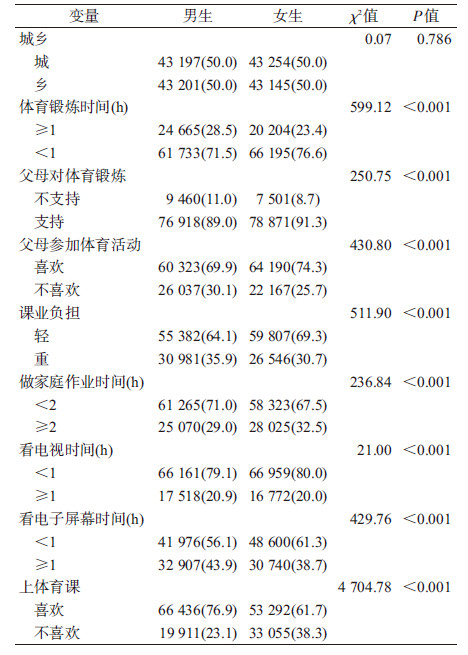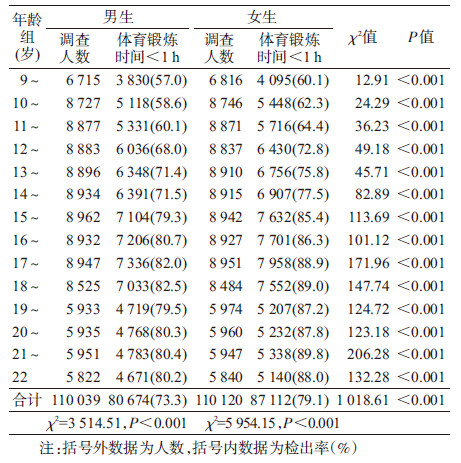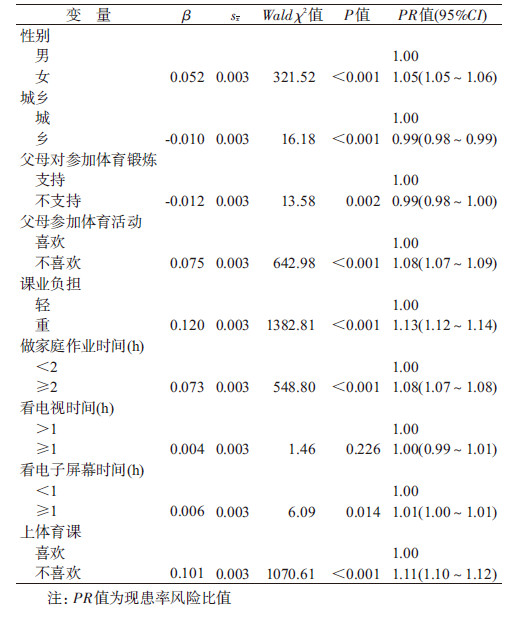文章信息
- 王政和, 董彦会, 宋逸, 杨忠平, 马军.
- Wang Zhenghe, Dong Yanhui, Song Yi, Yang Zhongping, Ma Jun.
- 中国2014年9~22岁学生体育锻炼时间不足1小时的流行现状与影响因素分析
- Analysis on prevalence of physical activity time < 1 hour and related factors in students aged 9-22 years in China, 2014
- 中华流行病学杂志, 2017, 38(3): 341-345
- Chinese journal of Epidemiology, 2017, 38(3): 341-345
- http://dx.doi.org/10.3760/cma.j.issn.0254-6450.2017.03.013
-
文章历史
收稿日期: 2016-09-20
儿童青少年体育锻炼对身体素质的健康发展至关重要。研究显示,1990-2010年中国儿童青少年体质健康状况呈持续下降趋势[1-3]。《中共中央国务院关于加强青少年体育增强青少年体质的意见》(2007年)(7号文件)建议儿童青少年每天应进行至少1 h的体育锻炼[4]。同时期美国、澳大利亚、英国、日本和加拿大等国家也相继发布了以通过加强体力活动增进国民健康水平为宗旨的指导方针和行动计划[5-9]。近年来,我国各级政府进一步落实了7号文件中“确保学生每天锻炼一小时”的建议,但尚无全国范围内学生体育锻炼时间<1 h的检出情况及其影响因素研究。因此,本研究藉“2014年全国学生体质与健康调研”数据,分析我国学生锻炼时间<1 h的检出情况及其影响因素。
对象与方法1.研究对象:源自“2014年中国学生体质与健康调研”数据。该调研采用分层整群抽样方法抽取研究对象,从中选取体育锻炼时间、父母对孩子体育锻炼的态度、父母自身对体育锻炼的态度、课业负担和对体育锻炼的态度等问卷调查资料完整的9~22岁人群作为研究对象,共220 159人。
2.问卷调查:该调研对体检样本中所有小学4~6年级、初中、高中和大学男女生进行标准化的问卷调查。主要包括学生对体育锻炼重要性的认识程度、参加体育锻炼的时间及强度、学生不愿意积极参加锻炼的原因等内容。
3.指标定义及分组:体育锻炼时间是指学生在校期间参加所有体育活动(包括课间操、体育课和课外体育活动)的时间总和,按照7号文件中“确保学生每天锻炼一小时”的建议,将研究对象分为体育锻炼时间<1 h和≥1 h两组;将“2014年全国学生体质与健康调研”问卷中可能与体育锻炼时间有关的个体水平变量纳入本研究。将父母均支持学生参加体育锻炼定义为“支持”,否则为“不支持”;将父母都喜欢在业余时间参加体育活动定义为“喜欢”,否则为“不喜欢”;将目前的课业负担很重和比较重定义为“课业负担重”,而将一般和不重者定义为“课业负担轻”;将放学后平均每天用于做家庭作业的时间分为<2 h和≥2 h两组;将平均每天看电视的时间分为<1 h和≥1 h两组;将平均每天用手机、计算机、电子游戏机等玩游戏、看视频或电子书的时间统称为电子屏幕时间,分为<1 h和≥1 h两组;将非常喜欢和喜欢上体育课定义为“喜欢”,否则为“不喜欢”。
4.统计学分析:采用SAS 9.2软件进行统计学分析,计数资料以人数(%)形式呈现;采用χ2检验进行各年龄组男女生体育锻炼时间<1 h流行率的比较,同时采用χ2线性趋势检验分别检验男女生9~22岁体育锻炼时间<1 h流行率随年龄增长的线性趋势;采用log-binomial回归模型,以体育锻炼时间<1 h为因变量,城乡、性别、父母是否支持体育锻炼、父母是否喜欢参加体育活动等变量为自变量,分别进行单因素和多因素log-binomial回归分析影响中国学生体育锻炼时间<1 h的影响因素。检验水准α=0.05。
结果1.基本特征:220 159名9~22岁学生中男生110 039人,女生110 120人。男生体育锻炼时间<1 h的流行率为71.5%,低于女生的76.6%,差异有统计学意义(P<0.001)。男生父母不支持体育锻炼、父母都不喜欢参加体育活动、课业负担重、看电子屏幕时间>1 h的报告率均显著高于女生(均P<0.001),而做家庭作业时间>2 h和不喜欢上体育课的报告率低于女生,差异有统计学意义(均P<0.001)。见表 1。
2.体育锻炼时间<1 h的检出情况:男生体育锻炼时间<1 h的平均流行率为73.3%,其中以9岁组最低(57.0%),18岁组最高(82.5%);女生体育锻炼时间<1 h的平均流行率为79.1%,也以9岁组最低(60.1%),但21岁组最高(89.8%)。总体而言,女生体育锻炼时间<1 h的流行率显著高于男生(P<0.001),各年龄组女生体育锻炼时间<1 h的流行率均显著高于男生(均P<0.001),且男女生体育锻炼时间<1 h的流行率均有随年龄增加而上升的趋势(趋势检验P<0.001)。见表 2。
3.体育锻炼时间<1 h影响因素分析:
(1)单因素分析:以体育锻炼时间<1 h为因变量,分别以性别、城乡、父母支持体育锻炼、父母喜欢参加体育活动、课业负担、写家庭作业时间、看电视时间、看电子屏幕时间和对上体育课的态度为自变量,采用log-binomial回归模型分析影响学生体育锻炼时间<1 h的影响因素,表 3显示女生、父母不喜欢参加体育活动、课业负担重、做家庭作业时间长、看电视时间长、看电子屏幕时间长和不喜欢上体育课均是体育锻炼时间<1 h的危险因素(均P<0.05),现患率风险比(PR)值分别为1.07、1.14、1.19、1.15、1.02、1.09、1.03和1.18;而父母不支持参加体育锻炼可能是学生体育锻炼时间<1 h的保护因素(P<0.05),PR=0.93。
(2)多因素分析:以体育锻炼时间<1 h为因变量,以性别、城乡、父母支持体育锻炼、父母喜欢体育活动、课业负担、写家庭作业时间、看电视时间、看电子屏幕时间和对上体育课的态度为自变量,采用多因素log-binomial回归模型分析,表 4显示女生(PR=1.05,95%CI:1.05~1.06)、父母不喜欢参加体育活动(PR=1.08,95%CI:1.07~1.09)、课业负担重(PR=1.13,95%CI:1.12~1.14)、做家庭作业时间长(PR=1.08,95%CI:1.07~1.08)、看电子屏幕时间长(PR=1.01,95%CI:1.00~1.01)和不喜欢上体育课(PR=1.11,95%CI:1.10~1.12)可能是学生体育锻炼时间<1 h的危险因素,居住乡村(PR=0.99,95%CI:0.98~0.99)、父母不支持参加体育锻炼(PR=0.99,95%CI:1.98~1.00)可能是学生体育锻炼时间<1 h的保护因素,而与看电视时间无关(P=0.226)。
我国历次学生体质与健康调研结果显示,1985-2005年中小学各年龄组男女生身体素质均呈现持续下降趋势[10],2010年下降趋势基本得到遏止[11],到2014年时呈现向好的趋势,但1985-2014年大学生身体素质呈持续下降的趋势。这可能与学生课业负担大、升学压力大而导致体育锻炼习惯差和时间少密切相关。研究显示,2010年我国中小学生体育锻炼时间≥1 h的学生仅占22.7%[12]。
本研究基于“2014年全国学生体质与健康调研”数据分析我国9~22岁学生体育锻炼时间<1 h的流行率高达76.2%,即仅有23.8%的学生体育锻炼时间>1 h,较2010年的达标率高[12]。各年龄组女生体育锻炼时间<1 h的流行率显著高于男生,可能与男生对课外体育“锻炼兴趣及价值取向”的认同度普遍较高有关[13]。学生体育锻炼时间<1 h的流行率随年龄的增加而增加,其中以16~18岁学生的流行率最高,说明高中阶段升学压力及课业负担可能是影响学生体育锻炼时间<1 h的主要原因;但大学生课业负担相对较轻,而体育锻炼时间<1 h流行率>80%,其中女生的流行率接近90%,说明大学生的体育锻炼时间较少、体育锻炼习惯较差,这与中小学阶段未培养较好的体育锻炼习惯密切相关。
由于体育锻炼时间<1 h的流行率较高,本研究采用log-binomial评估其关联[14]。结果显示,女性、父母不喜欢参加体育活动、课业负担重、做家庭作业时间长、看电子屏幕时间长和不喜欢上体育课可能是学生体育锻炼时间<1 h的危险因素。除了学生课业负担大、看电子屏幕时间长等自身原因外,父母是否积极参加体育活动对孩子体育锻炼时间<1 h的影响较大。提示为了培养学生良好的体育锻炼习惯和提高自身的健康水平,父母在业余时间应积极参加体育活动。
本研究为横断面调查,对于探讨学生体育锻炼时间<1 h的影响因素仅限于关联性分析;此外文中未定义体育锻炼的强度。但本研究基于“2014年全国学生体质与健康调研”数据,还是能较好揭示中国学生体育锻炼时间<1 h的现状及其可能的影响因素。
志谢: 感谢参加“2014年全国学生体质与健康调研”的现场工作人员及参与调查的学生和家长的理解与支持利益冲突: 无
| [1] |
杨贵仁.
2000年全国学生体质健康状况调研结果[J]. 中国学校卫生, 2002, 23(1): 2–3.
Yuan GR. Findings of physical fitness and health conditions of Chinese students in 2000[J]. Chin J Sch Health, 2002, 23(1): 2–3. DOI:10.3969/j.issn.1000-9817.2002.01.002 |
| [2] |
刘志敏, 李丽, 凌青东.
1985年与2000年辽宁省学生体质健康状况比较研究[J]. 北京体育大学学报, 2002, 25(3): 357–358.
Liu ZM, Li L, Ling QD. Comparison and research on physique and health state of students in Liaoning Province of China in 1985 and 2000[J]. J Beijing Univer Physic Edu, 2002, 25(3): 357–358. DOI:10.3969/j.issn.1007-3612.2002.03.025 |
| [3] |
汪玲.
从全国学生体质健康调研与监测谈提高学生体质健康水平策略[J]. 中国学校卫生, 2011, 32(5): 513–515.
Wang L. Strategies for improving students 'physical health level from the investigation and monitoring of students'physical health[J]. Chin J Sch Health, 2011, 32(5): 513–515. |
| [4] |
中国民族教育.
中共中央国务院关于加强青少年体育增强青少年体质的意见[J]. 中国学校卫生, 2007, 28(6): 481–483.
China National Education. Suggestion of CPC Central Committee and State Council on strengthening the youth sports to enhance youth physical[J]. Chin J Sch Health, 2007, 28(6): 481–483. |
| [5] | USDHHS. 2008 physical activity guidelines for Americans[R]. Washington DC:USDHHS, 2008. DOI:10.4085/1062-6050-44.1.5. |
| [6] | Department of Health PA, Health Improvement and Prevention. At least five a week:evidence on the impact of physcal activity and its relationship to health[EB/OL].[2016-09-19]. http://www.dh.gov.uk/en/Publicationsandstatistics/PublieationsPolicyAndGuidance/DH_4080994. |
| [7] | Australia's physical activity recommendations for 12-18 year olds[EB/OL].[2016-09-19]. http://www.health.act.gov.au/e/health?a=sendfile&ft=p&fid=-225689077&sid=. |
| [8] | 厚生労働省局健康的な生活習慣病対策室. 健康運動ポインタを促進する2006-生活習慣病を予防するために[EB/OL]. [2016-09-19]. http://www.nih.go.jp/eiken/programs/pdf/exercise_guide_cn.pdf. |
| [10] |
中国学生体质与健康研究组.2005年中国学生体质与健康调研报告[M]. 北京: 高等教育出版社, 2007.
Chinese Student Physique and Health Study Group.Report on the physical fitness and health surveillance of Chinese school students[M].Beijing: Higher Education Press, 2007. |
| [11] |
中国学生体质与健康研究组. 2010年中国学生体质与健康调研报告[R]. 北京: 高等教育出版社, 2012.
Chinese students constitution and health research group. Reports on the physical fitness and health research of Chinese school students[R]. Beijing:Higher Education Press, 2012. |
| [12] |
张芯, 宋逸, 杨土保, 等.
2010年中国中小学生每天体育锻炼1小时现状及影响因素[J]. 中华预防医学杂志, 2012, 46(9): 781–788.
Zhang X, Song Y, Yang TB, et al. Analysis of current situation of physical activity and influencing factors in Chinese primary and middle school students in 2010[J]. Chin J Prev Med, 2012, 46(9): 781–788. DOI:10.3760/cma.j.issn.0253-9624.2012.09.003 |
| [13] |
章建成, 张绍礼, 罗炯, 等.
中国青少年课外体育锻炼现状及影响因素研究报告[J]. 体育科学, 2012, 32(11): 3–18.
Zhang JC, Zhang SL, Luo J, et al. Research report on the status-quo and restrictive factors on the extracurricular physical exercise of the teenagers in China[J]. Chin Sport Sci, 2012, 32(11): 3–18. DOI:10.3969/j.issn.1000-677X.2012.11.001 |
| [14] |
叶荣, 郜艳晖, 杨翌, 等.
Log-binomial模型估计的患病比及其应用[J]. 中华流行病学杂志, 2010, 31(5): 576–578.
Ye R, Gao YH, Yang Y, et al. Using log-binomial model for estimating the prevalence ratio[J]. Chin J Epidemiol, 2010, 31(5): 576–578. DOI:10.3760/cma.j.issn.0254-6450.2010.05.024 |
 2017, Vol. 38
2017, Vol. 38






